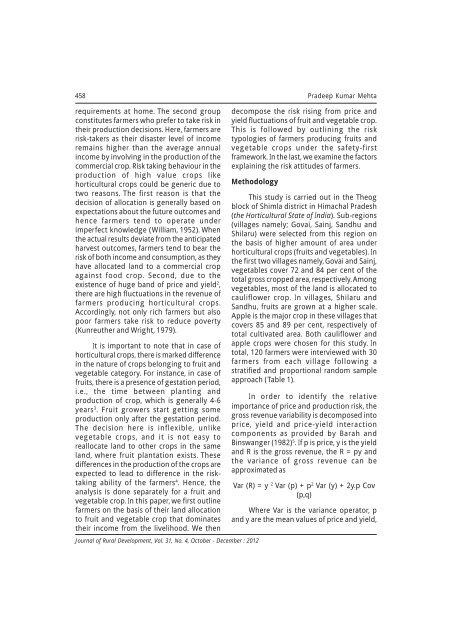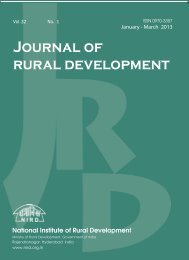October - December 2012 - National Institute of Rural Development
October - December 2012 - National Institute of Rural Development
October - December 2012 - National Institute of Rural Development
- No tags were found...
You also want an ePaper? Increase the reach of your titles
YUMPU automatically turns print PDFs into web optimized ePapers that Google loves.
458 Pradeep Kumar Mehtarequirements at home. The second groupconstitutes farmers who prefer to take risk intheir production decisions. Here, farmers arerisk-takers as their disaster level <strong>of</strong> incomeremains higher than the average annualincome by involving in the production <strong>of</strong> thecommercial crop. Risk taking behaviour in theproduction <strong>of</strong> high value crops likehorticultural crops could be generic due totwo reasons. The first reason is that thedecision <strong>of</strong> allocation is generally based onexpectations about the future outcomes andhence farmers tend to operate underimperfect knowledge (William, 1952). Whenthe actual results deviate from the anticipatedharvest outcomes, farmers tend to bear therisk <strong>of</strong> both income and consumption, as theyhave allocated land to a commercial cropagainst food crop. Second, due to theexistence <strong>of</strong> huge band <strong>of</strong> price and yield 2 ,there are high fluctuations in the revenue <strong>of</strong>farmers producing horticultural crops.Accordingly, not only rich farmers but alsopoor farmers take risk to reduce poverty(Kunreuther and Wright, 1979).It is important to note that in case <strong>of</strong>horticultural crops, there is marked differencein the nature <strong>of</strong> crops belonging to fruit andvegetable category. For instance, in case <strong>of</strong>fruits, there is a presence <strong>of</strong> gestation period,i.e., the time between planting andproduction <strong>of</strong> crop, which is generally 4-6years 3 . Fruit growers start getting someproduction only after the gestation period.The decision here is inflexible, unlikevegetable crops, and it is not easy toreallocate land to other crops in the sameland, where fruit plantation exists. Thesedifferences in the production <strong>of</strong> the crops areexpected to lead to difference in the risktakingability <strong>of</strong> the farmers 4 . Hence, theanalysis is done separately for a fruit andvegetable crop. In this paper, we first outlinefarmers on the basis <strong>of</strong> their land allocationto fruit and vegetable crop that dominatestheir income from the livelihood. We thenJournal <strong>of</strong> <strong>Rural</strong> <strong>Development</strong>, Vol. 31, No. 4, <strong>October</strong> - <strong>December</strong> : <strong>2012</strong>decompose the risk rising from price andyield fluctuations <strong>of</strong> fruit and vegetable crop.This is followed by outlining the risktypologies <strong>of</strong> farmers producing fruits andvegetable crops under the safety-firstframework. In the last, we examine the factorsexplaining the risk attitudes <strong>of</strong> farmers.MethodologyThis study is carried out in the Theogblock <strong>of</strong> Shimla district in Himachal Pradesh(the Horticultural State <strong>of</strong> India). Sub-regions(villages namely; Govai, Sainj, Sandhu andShilaru) were selected from this region onthe basis <strong>of</strong> higher amount <strong>of</strong> area underhorticultural crops (fruits and vegetables). Inthe first two villages namely, Govai and Sainj,vegetables cover 72 and 84 per cent <strong>of</strong> thetotal gross cropped area, respectively. Amongvegetables, most <strong>of</strong> the land is allocated tocauliflower crop. In villages, Shilaru andSandhu, fruits are grown at a higher scale.Apple is the major crop in these villages thatcovers 85 and 89 per cent, respectively <strong>of</strong>total cultivated area. Both cauliflower andapple crops were chosen for this study. Intotal, 120 farmers were interviewed with 30farmers from each village following astratified and proportional random sampleapproach (Table 1).In order to identify the relativeimportance <strong>of</strong> price and production risk, thegross revenue variability is decomposed intoprice, yield and price-yield interactioncomponents as provided by Barah andBinswanger (1982) 5 . If p is price, y is the yieldand R is the gross revenue, the R = py andthe variance <strong>of</strong> gross revenue can beapproximated asVar (R) = y 2 Var (p) + p 2 Var (y) + 2y.p Cov(p,q)Where Var is the variance operator, pand y are the mean values <strong>of</strong> price and yield,

















